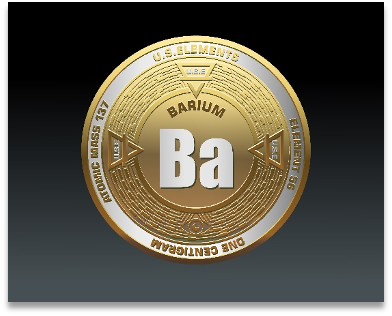Did you know that barite is so dense that it can make other minerals float? This high-density mineral is essential to oil and gas drilling, where it plays a crucial role in preventing blowouts. As the fourth installment of our Critical Minerals Series, we explore barite—a mineral that serves as the backbone of America’s energy industry and has increasing strategic importance in defense and technology.
Why the U.S. Needs Barite
Barite (BaSO₄) is a non-metallic mineral best known for its use in drilling muds in the oil and gas industry. The high density of barite allows it to act as a weighting agent, stabilizing boreholes during drilling operations and preventing dangerous pressure imbalances. Beyond oil and gas, barite is used in radiation shielding for hospitals and nuclear facilities, high-tech glass manufacturing, and even in medical diagnostics as a contrast agent in X-rays and CT scans. The mineral’s applications in defense include its role in military-grade paints and specialized electronics.
Where It’s Found Domestically
Barite deposits exist in several U.S. states, including Nevada, Georgia, and Missouri. However, despite having domestic reserves, U.S. barite production has dwindled due to lower-cost imports, primarily from China and India. Nevada is currently the leading producer, but refining limitations and cost challenges have hindered expansion.
Economic Realities
The barite market is driven by global oil and gas activity, making its demand cyclical. Prices fluctuate based on drilling needs and geopolitical factors affecting oil production. The U.S. is heavily import-dependent, with over 75% of barite coming from China, exposing the industry to potential supply chain disruptions. Given barite’s vital role in energy security, increasing domestic production could provide economic and strategic advantages.
Processing and Technological Innovations
Barite processing involves simple crushing, grinding, and flotation techniques. However, impurities such as silica and iron can limit its usability. New advancements in mineral purification and synthetic barite production could help reduce reliance on foreign sources. Additionally, research into recovering barite from drilling waste may provide a sustainable alternative.
Abundance and Waste Recovery Potential
Barite is relatively abundant, occurring at approximately 500 parts per million (ppm) in the Earth’s crust. While primary mining remains the main source, barite recovery from used drilling muds is an emerging area of interest. The ability to recycle barite from waste streams could enhance supply security and reduce environmental impacts.
Time to Market
Since barite does not require complex refining, new production sites could become operational within a few years if regulatory hurdles are addressed. Expanding domestic mining and recovery efforts would require investment but could significantly reduce reliance on imports in less than a decade.
Current and Future Applications
Barite’s traditional uses in oil and gas drilling remain dominant, but emerging applications are increasing its strategic importance. The medical field relies on high-purity barite for diagnostic imaging, while advanced ceramics and glass technologies benefit from its unique optical properties. The growing need for radiation shielding in space exploration and military applications also enhances its value.
Impact on Everyday Life
Without barite, routine medical procedures like barium X-rays would be impossible. The mineral also plays a hidden role in consumer electronics, automotive coatings, and even fireworks. As energy demands grow, barite’s function in oil and gas drilling remains a key component of modern infrastructure.
Consequences of Supply Shortages
A shortfall in barite supply could lead to increased drilling costs, potentially raising energy prices for consumers. The lack of stable domestic production leaves the U.S. vulnerable to export restrictions from China and other major suppliers. This supply chain risk could impact national energy security and industrial competitiveness.
Import Dependence
The U.S. imports the majority of its barite, with China and India supplying over 75% of demand. Supply chain disruptions, such as export restrictions or shipping delays, could have significant consequences for the energy and medical sectors. Investing in domestic mining and alternative sources of barite is crucial to reducing this dependence.
Securing America’s Barite Supply
To bolster domestic barite supply, the U.S. must take action through:
- Revitalizing domestic mining in states with known reserves.
- Developing recycling programs to recover barite from drilling waste.
- Exploring synthetic production as a long-term alternative.
By enhancing barite production within the U.S., we can strengthen our energy independence and national security while reducing exposure to foreign supply risks.
The Road to Mineral Independence Continues
Barite may not be a household name, but its importance to energy, defense, and healthcare cannot be overstated. As we push forward in securing America’s critical minerals, re-establishing a strong domestic barite supply must be a priority.
Join us next week as we continue our series with an exploration of another essential mineral shaping America’s future.
Let’s Make America Mineral Independent Again.






